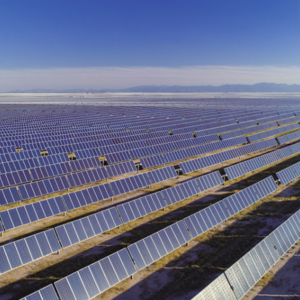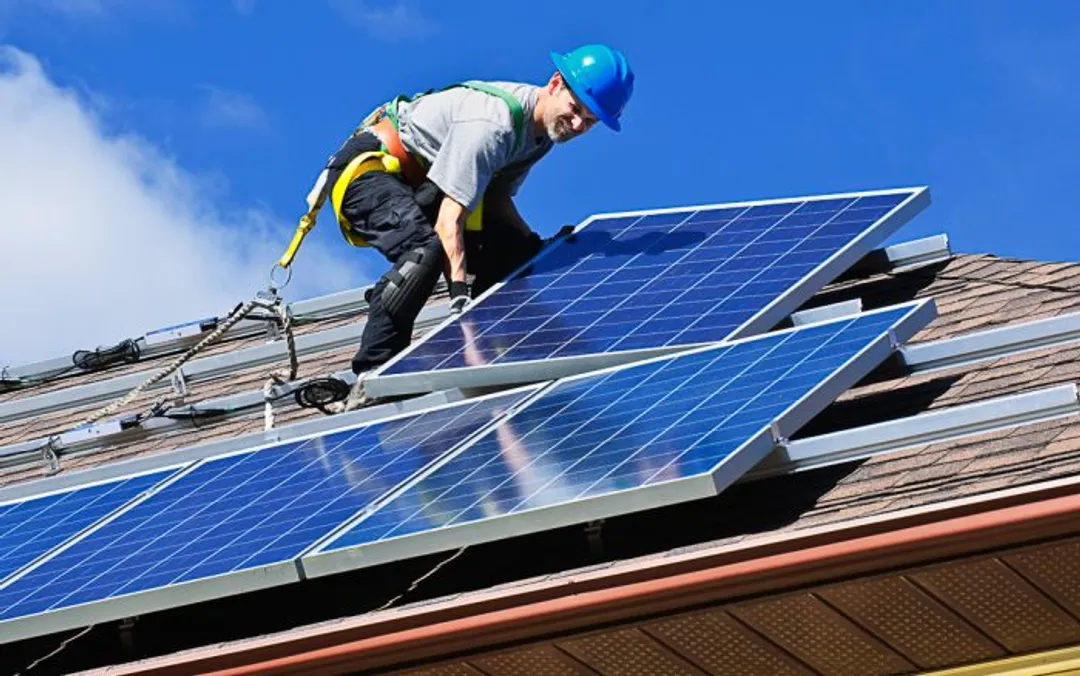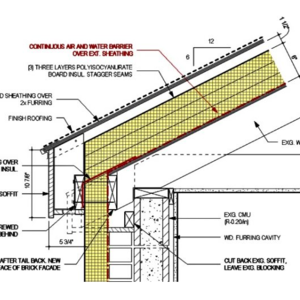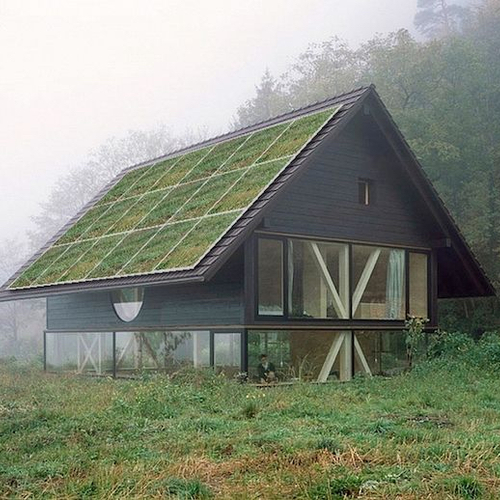
Roughly 2400 megawatts of new residential solar was deployed last year, the equivalent of 7.5 million 320-watt modules. That’s a big investment. Ever wonder what prevents all those panels from blowing away in a stiff breeze?
Solar mounting hardware—the racks, clips, and bolts that keep solar modules in place—is a world all but invisible once the panels are installed. With any luck, homeowners will never have to worry about, or even see, the equipment over the 25-year-plus lifespan of their solar arrays. That’s what manufacturers and installers are banking on.
To that end, the industry has developed a variety of mounting systems that keep modules in place on virtually any type of roof, even in high-wind regions like south Florida. When a rooftop arrays isn’t feasible, a ground-mounted array is another option.
Hardware represents an estimated 3% of the overall cost of a residential solar array, according to data cited by EnergySage, a Boston-based firm that connects customers with solar installers. Hardware is the essential foundation of any installation, even if most homeowners are blissfully unaware of it.
“In our experience, most people don’t really want to know or need to know about that,” says Thomas Tutor, a branch manager for Maine-based Revision Energy. “They trust us to install it well and use high quality equipment that we’re going to stand behind regardless. So we make sure we choose equipment we believe in.”
Here’s a rundown on the variety of mounting options installers have to choose from.
Rooftop systems are the most common
Most residential solar arrays go on the roof where they’re safely out of harm’s way. The Solar Energy Industry Association, a trade group, lists a dozen and a half manufacturers of solar mounting hardware at its website, so installers have lots of…
Weekly Newsletter
Get building science and energy efficiency advice, plus special offers, in your inbox.

This article is only available to GBA Prime Members
Sign up for a free trial and get instant access to this article as well as GBA’s complete library of premium articles and construction details.
Start Free TrialAlready a member? Log in















17 Comments
I'm having my solar array installed this november. I however opted to use the ironridge rail and their flashfoot 2. Similar to the pegasus in the article but with a raised screw on cap that encapsulates the lag screw.
Very interesting blog - and great pictures!
One thing I wonder about is the clip attachments for standing-seam roofs. The concealed fasteners on the metal panels are typically about two ft oc. They are designed to keep the panels from blowing off, not hold down a large solar array. I don't know if this is really an issue of not.
I installed my own roof top system (24 panels on rails installed on a 45 degree snap lock hidden fastener metal roof in Canada) and would just like to add a few comments for other self-installers.
First, I personally question putting any panel system on shingle roofs. There is a strong likelihood that the panels will outlast the roof by 2-3 times and thus the cost of re-roofing becomes much more expensive. I feel that metal roofing is a much better choice and if installing panels it is worth considering upgrading the roof at the same time.
My panels were mounted on a roof with 2x4 strapping on 9" of foam and one manufacturer suggested that I could simply use long bolts that I think are of the type described in the article (screw thread on one end screwed into the strapping with a bolt thread on the other end to attach a bracket). On a 45 degree roof I could not see any way that these would not sag and flex because the maximum penetration would only be 1.5 inches through the strapping (I can't recall the recommended penetration for use of these bolts but it was much more than 1 1/2 inches and usually penetration is into a rafter).
I then looked at clamps designed for non-penetration of standard metal roofing panels and obtained samples for testing. In my area (Ontario), metal roofing is often 28 or 29 ga which is fairly thin, but it is usually backed by plywood. I calculated the maximum uplift force and then tried applying it to a clamp that was installed on a test panel - the clamp didn't fail but the metal on the panel completely failed and was torn apart at about 1/3 to 1/2 load. There were no specifications that I could find with regard to the thickness of the metal roofing material required for these connectors but be aware that roofing thickness is an issue.
In the end I went with a series of brackets that each used 4 screws into the roof decking with a mastic sealing compound incorporated into the joint. The rails attached to the brackets. This system was straightforward to install and easily handled the calculated load - it has worked flawlessly for several years now.
Rob,
Thanks for the feedback on your installation. That's very interesting. My worry was that the ribs on the snap-lock panels are designed to maintain a gap even when locked together, and the clips would have to deform them quite significantly to hold - but I didn't think the metal would fail! I'd be a lot more comfortable with the brackets you ended up using.
Typical profile of snap-lock panels: https://www.westform.com/products.php?s1=commercial&s2=prolok_12_16
Thanks for the feedback Rob. After observing an install (I was on site for the install in the FHB article attached to the blog post) I felt like I'd be willing to tackle an install myself, with perhaps some electrical consultation.
The company featured in that article, Namaste Solar, in Denver Co. recommends that you replace your roof before installing a PV array unless you believe your roof to have 10 years of life left. When it does come time to reroof, they will remove and store the panels for you while the reroof is done. I imagine that there is cost to that service (I don't actually remember what they said about that), but worth knowing that it is offered by the solar installer so that homeowners don't have to be concerned about roofers, who don't necessarily understand PV systems, tinkering with them or reinstalling them incorrectly.
Shingle roof deterioration is principally due to UV radiation so shielding the roof from solar radiation with PV panels will dramatically increase the life of the shingles.
John,
It's a good point re: the deterioration of shingles being shielded by the panels, but the panels don't cover the whole roof and in my experience shingles never last the length of time that they are guaranteed for (maybe this is due to the Canadian climate). I can't see that it would be cost effective to replace half the roof and it just seems to me to be a complication best avoided. In other areas it may not be an issue at all.
Hi John.
That seems obvious to me too, and maybe it would be possible to replace singles around the perimeter of an array (well, we know it is possible). But when I asked that question of the author of the FHB story, his response, and I'm paraphrasing, was, "Maybe...but we wouldn't make that promise to a homeowner."
Malcolm,
The other advantage of the brackets that I used are that they can be placed on pretty much any spacing dictated by the uplift load because they install on the flats between the ribs - plus they do not depend on how well the metal roof is attached.. But, I should also add that you could also just increase the number of clamp type connectors in order to handle the load even for 29 ga. roof panels (but the cost then increases rather quickly).
Rob,
I wonder what happens if the roofing comes loose or fails, but the clips are all fine? That's probably on the homeowner, not the solar installer. I don't see anything about relying on the fasteners specified to keep the metal roofing in place to support solar panels in the installation instructions for then metal roofing I usually use, so they are probably off the hook too.
There may be nothing in all of this, and they work just fine, but I wouldn't be comfortable using the clips without knowing more about their track record.
But, what about Tesla???
https://www.tesla.com/solarroof
https://www.bloomberg.com/news/articles/2019-08-29/more-tesla-solar-panel-cases-emerge-in-wake-of-walmart-suit
I have a 22 panel array on a roof in NH. The only space we have to fit the array is a 2 pitch dormer. The former owner had installed a standing seam metal roof (over existing asphalt). The 10° roof is not ideal, but the installation is still highly cost effective. We used s5! clips to attache the rails to each rib on the roof. If this were a pitch greater than it is, or if the rails were set other than flush to the roof, I would certainly be concerned with wind uplift pulling the entirety of metal roof off the dormer. I do have to push snow off the panels periodically through the winter, so I walk on the metal roof at least a half dozen times per winter. It may not last as long as a quality shingle roof would last under the same conditions. I suspect that the existing failure of our chimney flashing and poor detailing of penetrations will cause me to replace the metal roof within 10 years. In case anyone is wondering, I'm not a fan of metal roofs.
I would be interested in an article about designing new home roofs to facilitate solar. For instance, I just had an installer mention that planning the location of penetrations for plumbing vents can impact the number of panels that can fit on the roof. Discussion of things like optimum pitches and roof form would also be great.
Hi Hallie.
I'll add that to our to-do list. I think it is a good idea.
I second that idea.
I'm rebuilding my home from the slab up and would like to create the environment for a quick, smooth transition to solar in the near future.
Questions like slope considerations, materials, and even prewiring so that the future upgrade is much simpler. One metal roof installer told me that metal standing seam roofs aren't the best option for solar because the clamps can damage the seam they are attached to. They recommended metal shingles I think.
Hi Brian - I'm currently finishing a design for a full-gut (new 2nd story) - am struggling with design to accommodate a large array on the south slope. I don't see anything in search - any content on GBA (or FHB etc for that matter) that I'm missing?
Log in or become a member to post a comment.
Sign up Log in